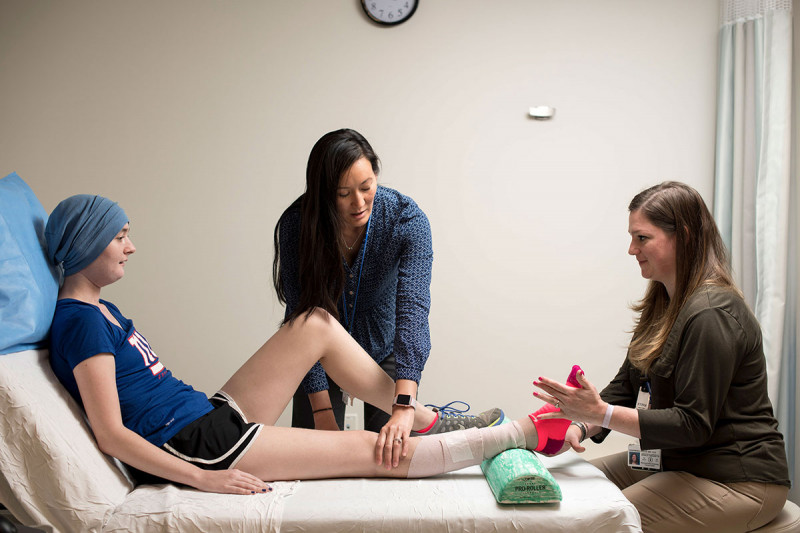
What is Oxycodone, and how does it help in treating cancer-related pain?
Oxycodone is a short-acting opioid. Oxycodone relieves pain due to cancer for about four to six hours, so it needs to be given 4 to 6 times a day to provide pain relief for the whole day. Oxycodone works by binding to specific receptors known as opioid receptors in the brain. The medicine is relatively selective for a type of opioid receptor, the mu-opioid receptor.
Oxycodone is a complete agonist at the mu receptor, meaning that it does not have a ceiling effect for pain relief. The risk of side effects, like CNS and respiratory depression, rises with higher doses, and the chances of overdosage increase. Buy Oxycodone online from us because we deliver authentic medicines.
Medical uses of Oxycodone in treating cancer-related pain

Oxycodone is given to relieve moderate-to-severe pain such as that due to cancer. This medication is usually given for acute pain following trauma or surgery. Higher dosages of Oxycodone are taken for increased pain relief. Oxycodone extended-capsules and extended-release tablets are used to control severe pain in patients expected to require pain medicines around the clock for a considerable amount of time and can’t be treated with other medication.
How should I take Oxycodone?
One can take Oxycodone with or without food, and patients usually take it every four to six hours. In case you experience nausea, you must take this medicine with food. You can discuss with your doctor other techniques to control nausea. It would be best to swallow whole Oxycodone tablets and not crush, chew, break, or dissolve them, leading to Oxycodone overdose by releasing all of the medicine at once. Take only a single Oxycodone tablet at a time to ensure you do not get choked if your prescribed dosage is for more than one tablet.
For adults over 18 years: It would be best if you took Oxycodone tablets at an interval of 4 to 6 hours. It also depends on the patient’s previous history of requirements of analgesic. Before starting treatment with Oxycodone, doctors must discuss with patients and put a strategy to end therapy with Oxycodone to reduce the possible risk of drug withdrawal syndrome. You must select the minimum effective dosage for analgesia. With the increased severity of pain, you must increase the dosage of Oxycodone tablets, using the different tablet strengths to achieve pain relief.
The correct dosage for any patient is that which controls the pain for a total of twelve hours. Patients must be titrated to pain relief unless uncontrolled extreme drug reactions prevent this. If there is a necessity for higher doses, you must make increments of 25% – 50%. The usual starting dose for patients who have not taken any opioid in the past or patients with severe pain unmanageable by opioids of lower strength is 10 mg. Some patients can benefit from an initial dose of 5 mg to reduce the occurrence of side effects. Oxycodone should not be used in minor patients.
Patients not previously exposed to opioids should not use Oxycodone 120 mg, 80 mg, and 60 mg tablets. These tablet strengths may cause dangerous respiratory depression when given to opioid naïve patients.
What should I avoid while taking Oxycodone?
One should not drink alcohol during the treatment with Oxycodone because that may increase the risk of experiencing adverse side effects. Also, share with your doctor if you are pregnant or are planning to be pregnant because Oxycodone could lead to severe withdrawal symptoms in the baby. Inform the baby’s doctor immediately if the baby experiences hyperactivity, uncontrolled shaking, abnormal sleep, diarrhea, failure to gain weight, or vomiting.
It would be best to avoid consuming grapefruit while you are on this medication. Discuss with your doctor before doing so. The doctor prescribes the dosage according to your condition and response to the medication. Please do not increase the dosage or take it longer than the doctor prescribed. Stop taking the drug when directed to do so. If you stop taking Oxycodone suddenly, you may experience withdrawal symptoms. Therefore, you must strictly follow your doctor’s instructions regarding the same.
What are the potential side effects of Oxycodone in treating cancer-related pain?
Respiratory depression is likely to happen during the first one to three days of Oxycodone medication, after a dosage rise, or if a high amount of Oxycodone is taken. Children, older people, or those with existing respiratory conditions are likely to be more at risk. Respiratory depression can cause death. Stopping Oxycodone suddenly in a person who has become physically dependent on it may lead to withdrawal symptoms like irritability, pupil dilation, restlessness, a runny nose, watery eyes, muscle aches, sweating, insomnia, gastrointestinal complaints, like vomiting, abdominal pain, diarrhea, or nausea. Children born to women who are dependent on Oxycodone will also be dependent on Oxycodone physically.
Get emergency medical help if you show allergic reaction symptoms to Oxycodone: difficult breathing; hives; swelling of your throat, lips, face, or tongue. Opioid medicine can lead to breathlessness and even death. A person caring for you must seek emergency medical attention or give naloxone if you have difficulty in breathing, if you are hard to wake up, or have blue-colored lips. Call your doctor immediately if you have: · noisy breathing, breathing that stops during sleep, sighing, shallow breathing;
- a slow heart rate;
- a light-headed feeling;
- confusion, or unusual thoughts;
- seizure;
- low cortisol levels; or
- high levels of serotonin in the body.
Leave a Reply